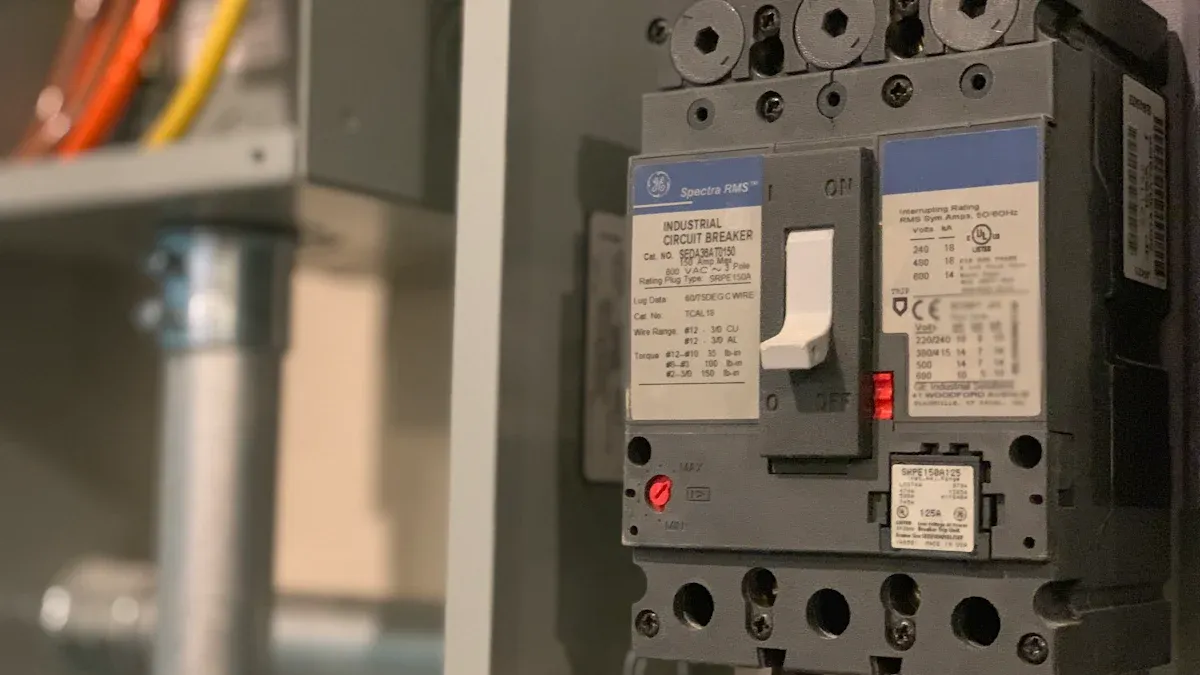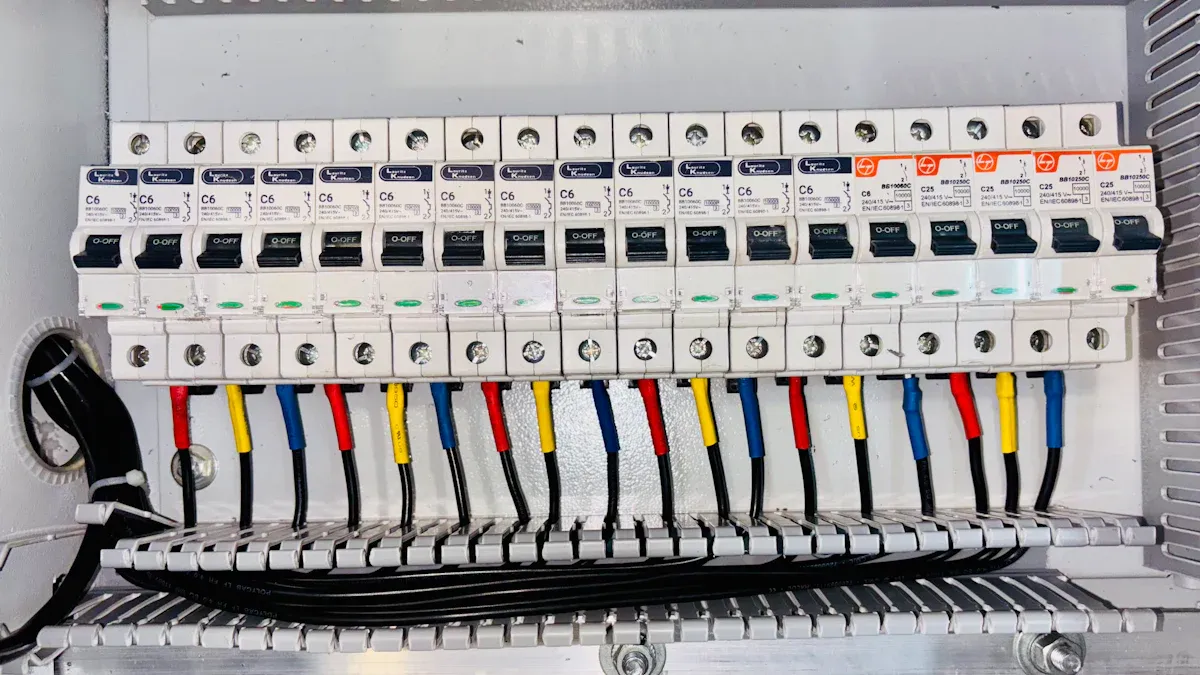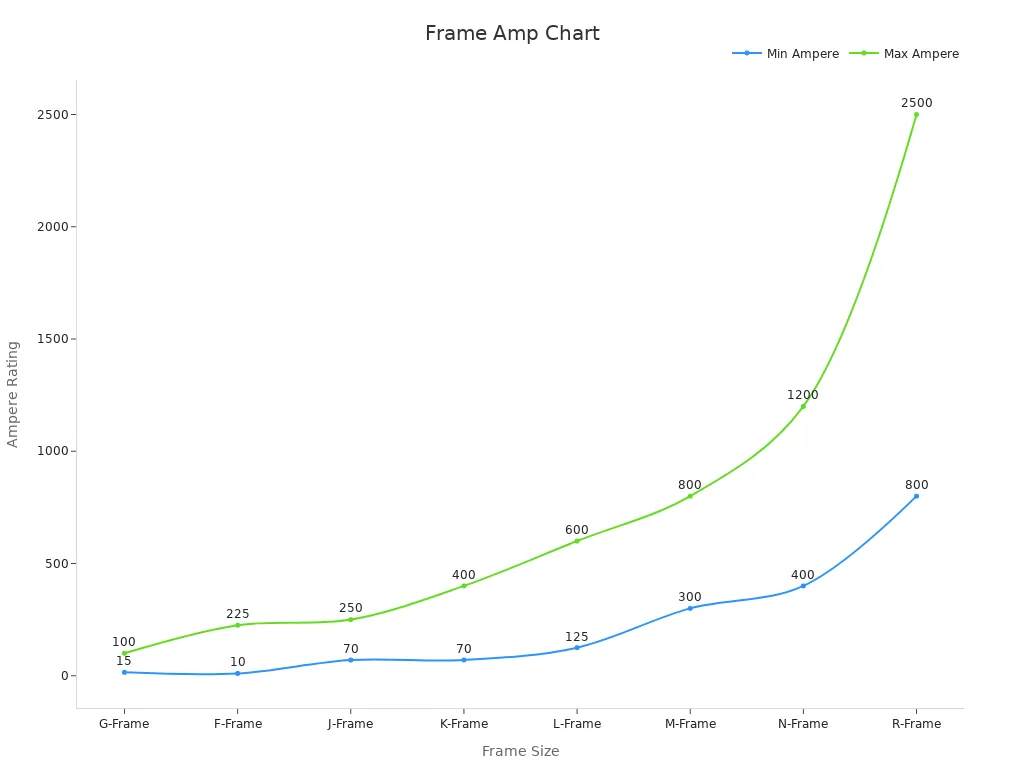A 500 ampere circuit breaker commonly uses a 600A or 800A frame, depending on the manufacturer. The frame size refers to the physical housing and maximum current capacity of the breaker, not just its ampere rating. Selecting the correct frame size ensures safe operation, reliable performance, and proper fit within electrical panels. Larger frames support higher currents and better heat dissipation, which is critical for high-current applications.
| Frame Designation | Ampere Range (A) |
|---|---|
| L-Frame | 125 – 600 |
| M-Frame | 300 – 800 |

Key Takeaways
- A 500 ampere circuit breaker usually fits into a 600A or 800A frame, which defines its physical size and maximum current capacity.
- Frame size sets the upper limit for the breaker’s rating and affects its heat dissipation, durability, and compatibility with electrical panels.
- Different manufacturers offer various frame options, so always check their catalogs to select the right frame for your breaker.
- Choosing the correct frame size ensures safe operation, proper fit in panels, and compliance with electrical codes.
- Larger frames provide more space for internal parts, better heat management, and allow for future upgrades or higher current ratings.
500 Ampere Circuit Breaker Frame Size

Common Frame Sizes
A 500 ampere circuit breaker does not always use a frame that matches its ampere rating. Manufacturers design circuit breakers with standard frame sizes that cover a range of current ratings. For a 500 ampere circuit breaker, the most common frame sizes include 600A, 800A, and sometimes 1000A. The frame size represents the maximum current the breaker housing can safely handle, not just the specific rating of the installed breaker.
Note: The frame size sets the upper limit for the breaker’s ampere rating. For example, a 600A frame can support breakers rated from 250A up to 600A.
Here is a table showing typical frame sizes for a 500 ampere circuit breaker:
| Breaker Ampere Rating | Typical Frame Size(s) |
|---|---|
| 500A | 600A, 800A, 1000A |
Choosing the correct frame size ensures the breaker can safely interrupt high currents and fit into standard electrical panels. Larger frames provide more space for internal components, which helps with heat dissipation and durability.
Manufacturer Variations
Different manufacturers may offer unique frame size options for a 500 ampere circuit breaker. For example, Square D often uses the L-frame (up to 600A) or M-frame (up to 800A) for this rating. Eaton may provide similar or slightly different frame designations. Some brands might offer a 500 ampere circuit breaker only in an 800A frame, while others allow selection between 600A and 800A frames.
- Square D: L-frame (600A), M-frame (800A)
- Eaton: Series C (600A), Series G (800A)
- Siemens: Sentron (600A), VL (800A)
Tip: Always check the manufacturer’s catalog or datasheet for exact frame size options. Frame size affects not only the physical dimensions but also the mounting style and accessories available for the breaker.
Manufacturers design their products to meet industry standards, but small differences in frame size or configuration can impact installation and compatibility. Selecting the right frame size for a 500 ampere circuit breaker helps ensure safe operation and compliance with electrical codes.
What Is Frame Size?
Definition
Frame size describes the physical size and configuration of a circuit breaker. In circuit breaker construction, the frame acts as the insulated housing that holds all the internal components. Plant Engineering’s manual explains that the frame determines both the physical dimensions of the breaker and the maximum voltage and current ratings it can safely handle. Manufacturers design frames to group breakers with similar shapes and mounting styles. This approach allows electricians to select breakers for different current ratings while keeping installation consistent.
A frame size often appears as a number, such as 600A or 800A. This number shows the highest ampere rating that the frame can support. For example, a 600A frame can house breakers rated anywhere from 250A up to 600A. The frame size also affects the accessories and mounting hardware that fit the breaker.
Note: The frame size does not change based on the breaker’s actual ampere rating. It stays the same for all breakers within that group.
Frame Size vs. Ampere Rating
Frame size and ampere rating serve different purposes in electrical systems. Frame size groups breakers by their physical design and sets the upper limit for current ratings within that group. The ampere rating, sometimes called ampacity, tells how much current a specific breaker or conductor can carry without overheating.
Electrical safety standards highlight this difference. Frame size, measured in amperes, refers to the maximum rating available for a group of molded case circuit breakers. Ampacity, on the other hand, is the continuous current a conductor can safely carry under normal conditions. For example, a 600A frame may contain breakers rated at 400A, 500A, or 600A, but the ampere rating on the label shows the exact current the breaker will interrupt.
- Frame Size: Sets the maximum possible ampere rating for a breaker group.
- Ampere Rating: Shows the actual current a breaker or conductor can handle safely.
Understanding these terms helps electricians choose the right breaker for each application, ensuring both safety and compatibility.
Breaker Construction

Internal Components
A 500 ampere circuit breaker uses several key internal components that work together to ensure safe and reliable operation. The frame acts as the outer casing, providing mechanical strength and determining the overall size of the breaker. Current carrying contacts conduct and interrupt high current, making them essential for performance. The operating mechanism allows for manual or automatic operation, and its size depends on the frame size. The tripping unit detects abnormal currents and triggers the breaker to open, with compatibility linked to the frame. The arcing chamber extinguishes electrical arcs during interruption, protecting the contacts from damage.
The following table outlines the typical frame sizes and their ampere ranges, showing how frame size determines the physical switch part and the range of trip units that can be attached:
| Frame Size | Ampere Range (A) |
|---|---|
| G-Frame | 15–100 |
| F-Frame | 10–225 |
| J-Frame | 70–250 |
| K-Frame | 70–400 |
| L-Frame | 125–600 |
| M-Frame | 300–800 |
| N-Frame | 400–1200 |
| R-Frame | 800–2500 |
Larger frames in a 500 ampere circuit breaker allow for more robust internal components, better heat dissipation, and increased flexibility in trip unit settings.

Physical Dimensions
Frame size directly affects the physical dimensions of a circuit breaker. For example, a 600A frame, which is common for a 500 ampere circuit breaker, typically measures about 16 inches in height, 8 inches in width, and 6 inches in depth. These dimensions can vary slightly by manufacturer, but larger frames always result in a bigger and heavier breaker.
- Height: ~16 inches
- Width: ~8 inches
- Depth: ~6 inches
Larger frames provide more space for internal components, which improves thermal and mechanical stability. Bigger frames also allow for future upgrades, as they can accommodate higher ampere ratings if needed. Proper frame size ensures the breaker fits securely in electrical panels and meets safety standards.
Installation and Application
Panel Compatibility
Frame size plays a major role in how a circuit breaker fits into an electrical panel. Each panel has specific mounting requirements and space limitations. A 500 ampere circuit breaker with a 600A or 800A frame will need a panel that supports its physical dimensions and mounting style. Electricians must check the panel’s specifications before installation. If the frame is too large, the breaker will not fit or may block access to other components. If the frame is too small, it may not provide enough support or protection.
Most commercial and industrial panels list compatible frame sizes in their documentation. Manufacturers often provide tables or diagrams that show which frames fit each panel model. This information helps installers avoid costly mistakes and ensures a secure fit. Proper panel compatibility also allows for easier maintenance and future upgrades.
Tip: Always verify the panel’s maximum frame size before selecting a 500 ampere circuit breaker. This step prevents installation delays and ensures code compliance.
Safety Considerations
Selecting the correct frame size for a 500 ampere circuit breaker is essential for safety and code compliance. Research shows that the breaker’s interrupting capacity must meet or exceed the maximum fault current at the installation point. If the frame size is too small, the breaker may fail during a fault, leading to equipment damage or fire. Larger frames support higher interrupting capacities and provide better heat dissipation.
Environmental factors also affect safety. Breakers must operate within rated temperature ranges and withstand conditions like moisture or vibration. Manufacturers test and calibrate breakers to ensure reliable performance. Sealed breakers prevent tampering and maintain consistent operation.
Typical applications for a 500 ampere circuit breaker include large commercial buildings, manufacturing plants, and data centers. These settings require breakers that can handle high currents and provide dependable protection. Proper frame size selection, combined with coordination strategies, improves operational reliability and protects both people and equipment.
Selecting the right frame size for a 500 ampere circuit breaker ensures safe, reliable operation in demanding environments. Frame size impacts installation, current-carrying capacity, and thermal performance.
- It determines the breaker’s dimensions, mechanical strength, and ability to handle high currents.
- Larger frames improve heat dissipation and support robust internal components.
To maintain code compliance and safety, professionals should:
- Consult detailed manufacturer specifications.
- Follow industry standards and calibration practices.
- Review relevant codes before final selection.
Careful selection protects equipment and supports long-term system reliability.
FAQ
What does frame size mean in a circuit breaker?
Frame size describes the physical housing and maximum current capacity of a circuit breaker. It sets the upper limit for the breaker’s ampere rating and determines the breaker’s dimensions and mounting style.
What factors affect the choice of frame size for a 500 ampere breaker?
Engineers consider panel compatibility, required interrupting capacity, and manufacturer options. They also review installation space and future upgrade needs. These factors help ensure safe and reliable operation.
What applications use 500 ampere circuit breakers?
Large commercial buildings, factories, and data centers often use 500 ampere circuit breakers. These breakers protect equipment and wiring in systems that carry high electrical loads.
What happens if someone selects the wrong frame size?
Using the wrong frame size can cause safety hazards. The breaker may not fit the panel or may fail to interrupt fault currents. This mistake can lead to equipment damage or fire.
What accessories might a 500 ampere breaker require?
A 500 ampere breaker may need shunt trips, auxiliary contacts, or mounting hardware. These accessories support remote operation, status monitoring, and secure installation. Always check manufacturer recommendations.
The following information may be of interest to you
What is the frame size of a 60a circuit breaker
Molded case circuit breaker 125 ampere 4P
Analysis of the cause of air conditioning circuit breaker tripping



